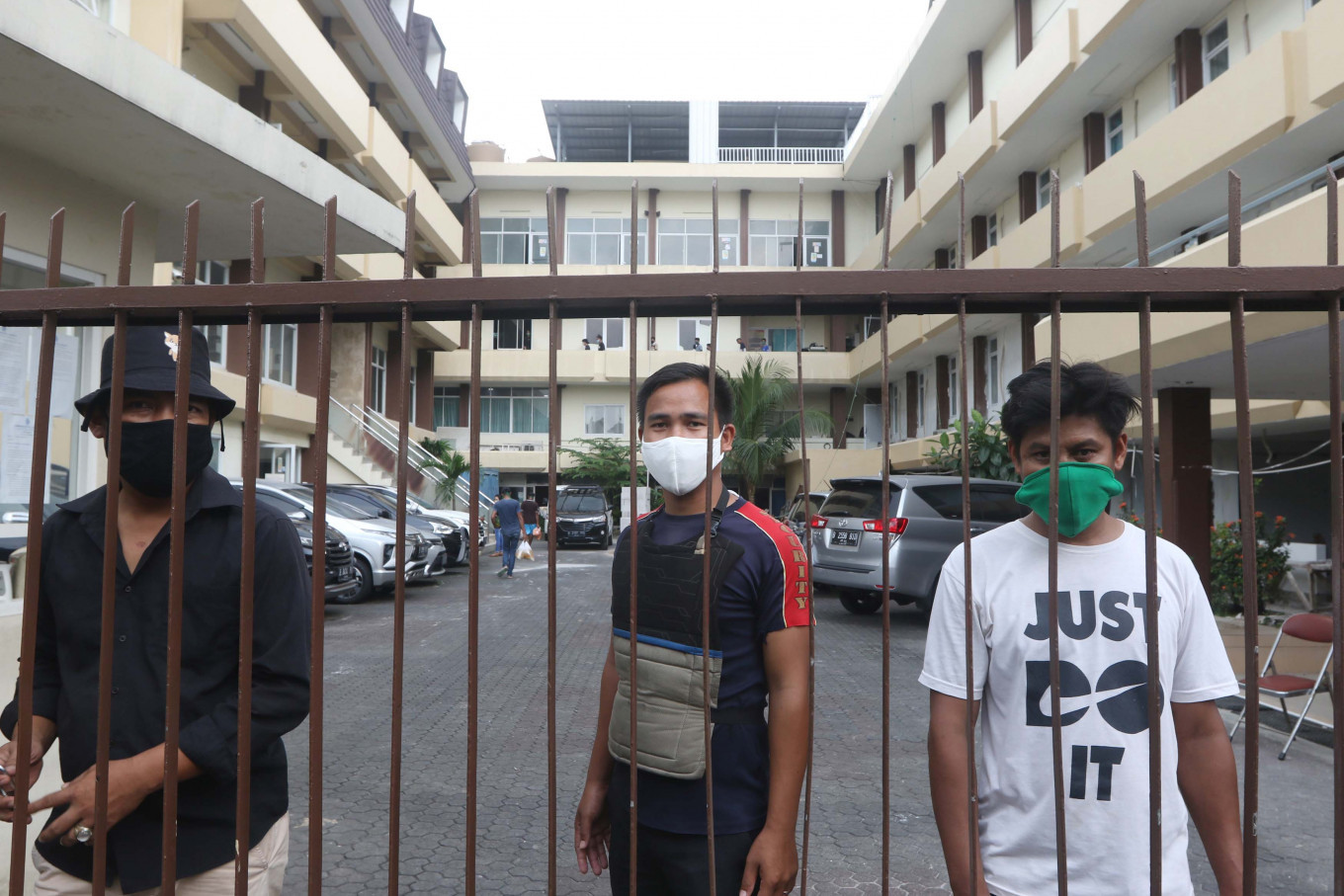Popular Reads
Top Results
Can't find what you're looking for?
View all search resultsPopular Reads
Top Results
Can't find what you're looking for?
View all search resultsNew joint command faces first test under COVID-19
Initially, attention on Kogabwilhan has been largely on its capacity to improve the TNI’s readiness to maintain security at Indonesia’s borders.However, its support of efforts to handle the pandemic has brought attention to its roles in non war military operations.
Change text size
Gift Premium Articles
to Anyone
A
new structure within the Indonesian Military (TNI) is given its first test in conducting military operations other than war (MOOTW), as it assists the government to handle the pandemic.
The Joint Regional Defense Command (Kogabwilhan) was formed in September 2019, to organize the TNI’s deployment into three theaters of operations — Kogabwilhan I, II and III — each responsible for overseeing the mobilization of combat units in Indonesia’s western, central and eastern parts, respectively.
Initially, attention on Kogabwilhan has been largely on its capacity to improve the TNI’s readiness to maintain security at Indonesia’s borders.
However, its support of efforts to handle the pandemic has brought attention to its roles in non war military operations.
Kogabwilhan is positioned as one of the TNI’s main operational commands (Kotama Ops), along with, among others, the Army’s regional military commands; the Navy’s fleet commands; the Air Force operations commands; and the Marine Corps.
Although Kogabwilhan sits equally with the other Kotama Ops, it is the “first responder” in the event of an attack or emergency; and is authorized to mobilize units from other Kotama Ops under its command.
As such, Kogabwilhan is expected to improve interoperability between the Army, Navy and Air Force through an overarching operational command for them.
For instance, in its first major task to drive away Chinese vessels in waters off Natuna Islands last January, Kogabwilhan I mobilized combined assets from the Navy’s First Fleet Command and the First Air Force Operational Command.
It was the largest deployment in Natuna so far; and the operation demonstrated a more integrated command and control across the services.
The presence of Kogabwilhan I commander Vice Admiral Yudo Margono also reduced the post’s dependence on the TNI commander, resulting in more flexibility for joint operations.
The creation of Kogabwilhan was also driven by a personnel logjam in the TNI — the significant surplus of high-ranking officers and colonels compared with the required number.
Apart from addressing external threats, Kogabwilhan also alters the dynamics of MOOTW. As the pandemic worsened, the government looked to the TNI to assist with logistical matters and additional healthcare support, as is always the case in emergencies.
While there are always concerns over military involvement in civilian affairs, their participation in natural and nonnatural disasters is inevitable and even expected, as they have logistical and structural capability in providing swift support.
In late March, TNI commander Air Chief Marshal Hadi Tjahjanto ordered the formation of an ad-hoc unit called the Integrated Joint Task Command (Kogasgabpad) to coordinate operations related to COVID-19, and appointed Kogabwilhan chief I Margono as the head. Margono supervises four task forces to manage quarantine and healthcare facilities: the task force of Wisma Atlet COVID-19 makeshift hospital in Jakarta; the task force of Pulau Sebaru off Jakarta’s coasts; and the task forces in Riau Islands overseeing Natuna and Pulau Galang, the site of a new COVID-19 hospital.
Similar ad-hoc task forces have also been formed in response to natural disasters under the TNI Command. However, the TNI will likely continue to use Kogabwilhan to organize these task forces.
Kogabwilhan’s involvement in the virus outbreak marks notable trends: it underlines the unit’s role as the “first responder” and improves inter-service cooperation across three TNI services. Previously, MOOTW were largely dominated by the Army.
This is understandable given the Army’s vast and penetrating territorial command system, which allows the service to maintain a presence through 15 military commands (Kodam) across Indonesia, each with substructures down to the village level, a legacy of the authoritarian New Order.
For instance, following the natural disasters in Lombok in West Nusa Tenggara and Palu in Central Sulawesi, respectively in August and September 2018, the TNI formed two Kogasgabpad led by Army generals. Most of the unit members were drawn from the Army’s Strategic and Reserve Command, with a small cohort from the Marine Corps.
They also worked closely with members of the Army’s military subdistrict commands and the lowest level of the Army’s territorial structure, the village supervisory noncommissioned officers (Babinsa).
However, the composition under the Kogasgabpad for COVID-19 was much more diverse, involving officers from the Army, Navy and Air Force. Margono himself is the former commander of the Navy’s First Fleet.
Although the Wisma Atlet and the Pulau Galang task forces are still headed by Army officers, the Natuna taskforce is led by the commander of the First Air Force Operation Command; while the Pulau Sebaru one is headed by the commander of the Navy’s First Fleet Command.
Such diverse appointments not only demonstrate the efforts to embrace the Navy and Air Force leadership, but also encourage interservice cooperation. Whether cooperation can really work also depends on the leadership.
So far, it is understandable that Kogabwilhan I is in charge of the COVID-19 task force, as most cases are in the nation’s western part. However, to anticipate future emergencies, attention must be paid to whether, and how, Kogabwilhan II and III will play equally significant roles.
Kogabwilhan’s existence does not mean the Army has lost its relevance. Many of its district and sub-district military commands are carrying out initiatives in handling the impacts and needs brought about by the pandemic albeit on a smaller scale, such as distributing supplies.
Additionally, the TNI’s influence is not limited to Kogabwilhan alone. Other TNI officers are also involved in other bodies, such as Army general Doni Monardo, who simultaneously heads the national COVID-19 task force and the National Disaster Mitigation Agency.
However, overall, the creation of Kogabwilhan has been one of the most significant additions to the TNI’s command structures in the past decade. Initiatives carried through Kogabwilhan also represent tangible efforts to improve the TNI’s readiness and interoperability.
Future development of its roles will depend on the TNI leadership at all levels.
So far, under TNI commander Hadi, who comes from the Air Force, Kogabwilhan has been able to introduce more diverse appointments; and has been trusted to handle major operations. Nevertheless, it is too early to tell whether such norms will prevail under different circumstances.
______
Senior analyst at the Indonesia Program, S. Rajaratnam School of International Studies at Nanyang Technology University, Singapore. The views expressed are her own.










